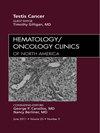Measurable/Minimal Residual Disease: What Method and What Cut-Off?
IF 2.7
3区 医学
Q2 HEMATOLOGY
引用次数: 0
Abstract
Minimal residual disease (MRD) testing has become a central response biomarker in clinical trials of time-limited treatment, with MRD-guided strategies under increasing evaluation. This article compares key technical and practical features of available MRD approaches and provides guidance on selecting the appropriate method and threshold for varied clinical applications.
可测量/最小残留疾病:什么方法和什么截止?
微小残留病(MRD)检测已成为有时限治疗临床试验的核心反应生物标志物,MRD指导的策略受到越来越多的评价。本文比较了现有MRD方法的关键技术和实际特点,并为不同临床应用选择合适的方法和阈值提供了指导。
本文章由计算机程序翻译,如有差异,请以英文原文为准。
求助全文
约1分钟内获得全文
求助全文
来源期刊
CiteScore
4.10
自引率
0.00%
发文量
86
审稿时长
6-12 weeks
期刊介绍:
Hematology/Oncology Clinics updates you on the latest trends in patient management, keeps you up to date on the newest advances, and provides a sound basis for choosing treatment options. Under the direction of an experienced guest editor, each issue focuses on a single topic in hematology and oncology, including hemostasis and thrombosis, molecular and cellular basis of hematology, coagulation disorders, and cancers—bone, gastrointestinal, head and neck, lymphomas, neuroendocrine, breast, renal cell, melanoma, and more.

 求助内容:
求助内容: 应助结果提醒方式:
应助结果提醒方式:


